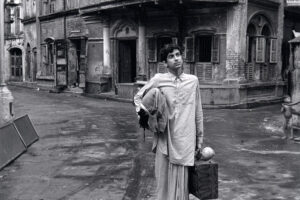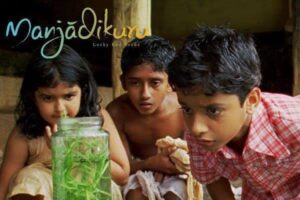Coming-of-age in Indian Cinema

Vikramaditya Motwane’s Udaan follows teen protagonist Rohan as he tries to live life on his own terms
The term “bildungsroman” was coined in 1819 and represents a coming-of-age tale of a young, inexperienced protagonist who embarks on a journey looking for life’s answers. Films such as Ladybird (2017) and The Breakfast Club (1985) are among many in Hollywood that have been acclaimed for portraying teenage angst. Although a rare subject in Indian cinema, the following films are some of the most critically acclaimed coming-of-age stories from different parts of the country. Most importantly, the central theme remains unchanged regardless of the era – the perilous transition from adolescence to adulthood, peppered with familial conflicts, teenage rebellion, and sexual and cultural awakening.
Apu Trilogy

Ray’s Apu trilogy influenced critically acclaimed directors such as Martin Scorsese
Comprising three Bengali-language drama films, Pather Panchali (1955), Aparajito (1956) and The World of Apu (1959), Satyajit Ray’s Apu Trilogy has been lauded as one of the most iconic and influential coming-of-age films of all time, across the globe, influencing world-renowned filmmakers, such as Martin Scorsese, Isao Takahata, and Abbas Kiarostami.
In Pather Panchali, Ray’s debut film, the titular character lives with his parents and sister in rural Bengal, where the simple pleasures of youth are illustrated through gorgeous cinematography. Their idyllic village life comes to an end when Apu’s beloved sister dies. In an attempt to escape grief and the chains of poverty that the family eventually sinks into, they move away from their family home. Apu’s life as a teenager and his transition from a carefree childhood to forced maturity is explored in the sequel Aparajito, where he struggles to reconcile his dreams of big-city life in Calcutta with his rural roots and ailing mother’s needs.
“The youthful coming-of-age dramas that have flooded art houses since the mid-fifties owe a tremendous debt to the Apu trilogy, which Terrence Rafferty has rightly called cinema’s purest Bildungsroman, emphasising the work’s timelessness in portraying the intricacies of growing up,” wrote film critic Michael Sragow in 1994.
In fact, the films were so legendary that after the original negatives were damaged in a fire in 1993, the remnants were painstakingly restored by hand in an initiative taken by The Academy Awards film archive, so that Ray’s art could be “discovered for a whole new generation of filmmakers and cinephiles.”
Mera Naam Joker

Raju’s toy clown is a symbol of his naive, never-ending love and hearbreak
Loosely based on his own life experiences, Raj Kapoor’s 1970 release was initially panned by critics and audiences, primarily for its five-hour runtime, but went on to become a cult classic. Rishi Kapoor debuts as Raju, a 16-year-old clown in a circus company. The main story of Raju’s adolescence is told in Chapter 1, through flashbacks to when he experiences his first heartbreak and explores his relationship with his parents, determined to follow in his deceased father’s footsteps to become an entertainer in a circus.
The toy clown that travels between the hands of Raju and the three most influential women in his life serves as a symbol of his own heart, given away or thrown into the sea whenever Raju experiences loss. The inimitability of the film lies in its blend of tragedy and comedy, as Raju is introduced as a character who is ultimately unsuccessful in love but strives to make his audience laugh regardless of his pain. His journey to adulthood is rife with emotional and physical changes, from a naïve, innocent young boy to exploring his first confrontation with sexual desire and insecurities of first love.
Manjadikuru

The children discover the simple joys of a summer spent together in their parents’ ancestral home
Manjadikuru is a Malyalam film released in 2008. Set in the 1980s, it is a homecoming story about a ten-year old boy named Vicky who returns from the Gulf to his parents’ village in rural Kerala to attend the last rites of his grandfather.
The film explores social and political issues through the eyes of the young child, whose naïve innocence is disturbed when he sees the fragmented nature and supressed rivalry and pain of his extended family, who immediately quarrel over ancestral property on the death of its patriarch.
The pure nature of a child, untainted by societal prejudices is depicted in how Vicky easily befriends Roja, the 12-year-old housemaid whose name is not even known by the people she works for. The heart of the movie is the warm companionship between the Roja and the three cousins, who discover the simple joys of a summer spent together eating mango, chocolate and fishing for toads. When he returns as a young man years later, he finds the “lucky red seeds” scattered around the familiar grounds, which is symbolic, he recalls, of untouched, imperfect beginnings or seeds that mature into beautiful endings or trees with newer, stronger roots.
The film won five grand jury awards at the South Asian International Film Festival (SAIFF) at New York, including Best Film, Best Director (Anjali Menon), Best Screenplay, Best Cinematographer and Best Emerging Talent.
Udaan

Rohan’s growing relationship with his half-brother Arjun, is one of the turning points of the film
Vikramaditya Motwane’s directorial debut Udaan (2010), which means taking flight, is aptly named as through the course of the movie, the film’s teenage protagonist Rohan eventually leaves his alcoholic, abusive father’s nest to try and live life on his own terms. Motwane’s strength lies in his no-frills depiction of broken and healed familial relationships.
After being expelled from boarding school for a series of misdemeanours, the latest of which involved viewing an adult film on campus, Rohan (Rajat Barmecha) is forced to live with a father he has not seen for 10 years. The audience gets drawn in by the nuanced portrayals of the two leads who navigate a father-son relationship fraught with conflict. Rohan dreams of becoming a writer, but is forced by Bhairav (played by Ronit Roy) to toil away at a metalworking factory. Motwane expertly portrays the theme of teenage rebellion; Rohan deals with the violence inflicted on him and his little brother at home by stealing, drinking with questionable seniors, and even getting arrested. One of the most touching moments of the film is when he realises his love for his half-brother, Arjun, whom he treats quite stoically in the beginning. Despite knowing him for only a few months, his protective nature prevails and they escape together to Mumbai.
The film was selected in the Un Certain Regard category at the 2010 Cannes Film Festival, the first time in 7 years that an Indian film was represented at Cannes and received a standing ovation. At home, it won 9 Filmfare awards, including the Critics Award for Best Film.









